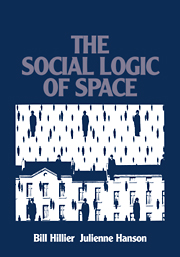Book contents
- Frontmatter
- Contents
- Preface
- Acknowledgements
- Introduction
- 1 The problem of space
- 2 The logic of space
- 3 The analysis of settlement layouts
- 4 Buildings and their genotypes
- 5 The elementary building and its transformations
- 6 The spatial logic of arrangements
- 7 The spatial logic of encounters: a computer-aided thought experiment
- 8 Societies as spatial systems
- Postscript
- Notes
- Index
1 - The problem of space
Published online by Cambridge University Press: 18 December 2009
- Frontmatter
- Contents
- Preface
- Acknowledgements
- Introduction
- 1 The problem of space
- 2 The logic of space
- 3 The analysis of settlement layouts
- 4 Buildings and their genotypes
- 5 The elementary building and its transformations
- 6 The spatial logic of arrangements
- 7 The spatial logic of encounters: a computer-aided thought experiment
- 8 Societies as spatial systems
- Postscript
- Notes
- Index
Summary
SUMMARY
The aim of this chapter is to argue for, and to establish, a framework for the redefinition of the problem of space. The common ‘natural’-seeming definition sees it as a matter of finding relations between ‘social structure’ and ‘spatial structure’. However, few descriptions of either type of structure have succeeded in pointing towards lawful relations between the two. The absence of any general models relating spatial structure to social formations it is argued, has its roots in the fundamental way in which the problem is conceputalised (which in turn has its roots in the ways in which social theorists have conceptualised society), namely as a relation between a material realm of physical space, without social content in itself, and an abstract realm of social relations and institutions, without a spatial dimension. Not only it is impossible in principle to search for necessary relations between a material and an abstract entity, but also the programme is itself contradictory. Society can only have lawful relations to space if society already possesses its own intrinsic spatial dimension; and likewise space can only be lawfully related to society if it can carry those social dimensions in its very form. The problem definition as it stands has the effect of desocialising space and despatialising society. To remedy this, two problems of description must be solved. Society must be described in terms of its intrinsic spatiality; space must be described in terms of its intrinsic sociality. The overall aim of the chapter is to show how these two problems of description can be approached, in order to build a broad theory of the social logic of space and the spatial logic of society.
- Type
- Chapter
- Information
- The Social Logic of Space , pp. 26 - 51Publisher: Cambridge University PressPrint publication year: 1984



